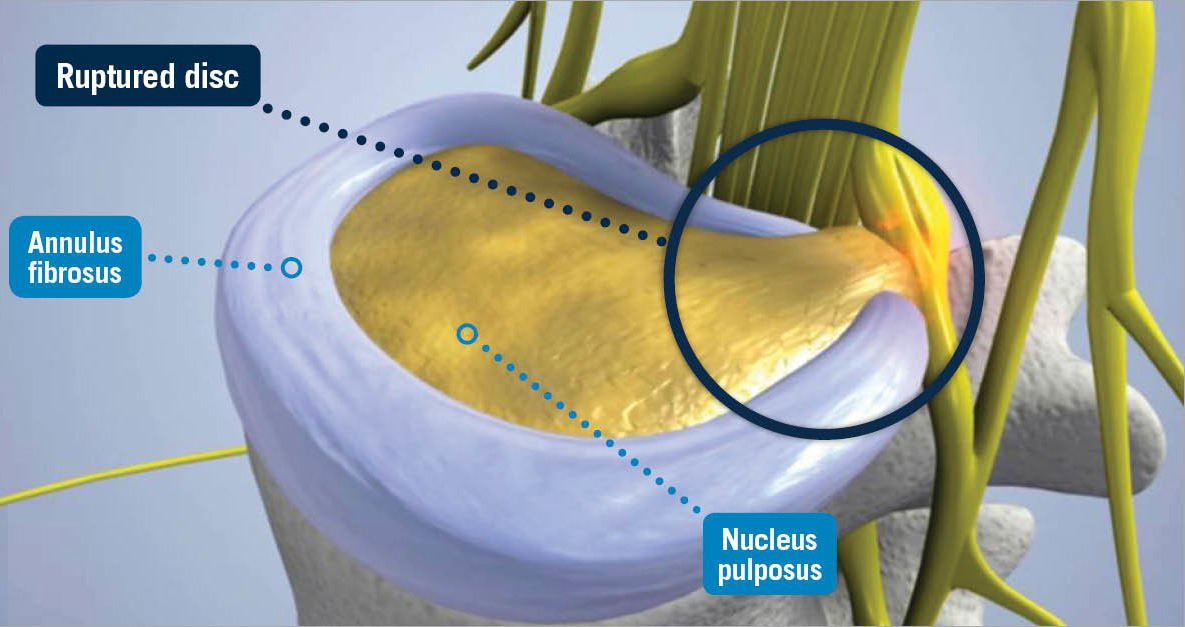- Conditions
- Procedures
- Patient care
- Why choose us
- Our Doctors
- Contact
Home » Spine Conditions »
Ruptured disc overview

A ruptured disc, also called a herniated disc, is a common condition that occurs when one of the spinal discs develops a crack in its tough outer wall and its inner disc material is pushed out into the spinal canal. This can result in pain and other symptoms if any displaced disc material puts pressure on the spinal cord or an exiting nerve root.
If discomfort and limited mobility from a ruptured disc have become debilitating and make it difficult for you to accomplish even simple tasks, learning about your condition through the following article is important. Being able to ask the right questions to your primary care doctor and better understand the answers may help you better get the care you need to resume a healthy and active life.
What causes a ruptured disc?
Ruptured discs can develop anywhere in the spine. Most develop in the lumbar (lower) spine, although the cervical (upper) spine area is also a common location for a ruptured disc. In many cases, a ruptured disc develops as a result of regular, age-related wear. The discs are made of soft but strong connective tissue and act as shock absorbers for the pressure placed on the neck and back every day. Throughout a person’s lifetime, these discs gradually lose the elasticity and water content that help keep them flexible.
The deterioration of the discs can cause the formation of small cracks to develop in the outer wall, which can further develop into full tears. Pressure from the surrounding vertebrae can then cause the fluid in the core of the disc to be pushed out through the tear and into the spinal column. Less commonly, a rupture can also be caused by a sudden traumatic injury such as a car crash. People whose jobs involve prolonged exposure to the regular lifting of heavy items are also prone to disc ruptures.
Common ruptured disc symptoms
It is possible to have a ruptured disc and experience few to no symptoms. However, if there is any nerve compression or irritation resulting from the disc rupturing, the following symptoms can result:
- Local pain
- Shooting or burning pain that travels the length of the nerve
- Numbness
- Muscle weakness
- Tingling
- Loss of movement
Treatment options for a ruptured disc
If you are experiencing any of these symptoms, be sure to contact your doctor. He or she will be able to determine the cause of the pain and the best possible treatments. When diagnosing a ruptured disc, your health care provider likely will perform a physical exam and may order an X-ray, CT scan or MRI for a confirmation. Conservative treatment options could include over-the-counter medication, prescription medication, physical therapy and lifestyle changes.
Some patients may need more than conservative treatments to relieve their symptoms and let them get back to the people and activities they’ve been missing. If this is the case, your doctor may recommend contacting USA Spine Care to learn about our minimally invasive spine surgery. As a safer and effective alternative to traditional open back surgery, our outpatient procedures are designed to remove ruptured disc material and help patients find relief while avoiding hospital-associated costs and enjoying a shorter recovery period.^
At USA Spine Care, we have helped more than 75,000 patients find relief from chronic neck and back conditions, such as a ruptured disc. Reach out to us today for a no-cost MRI review* to determine if you may be a candidate for our minimally invasive spine surgery.
